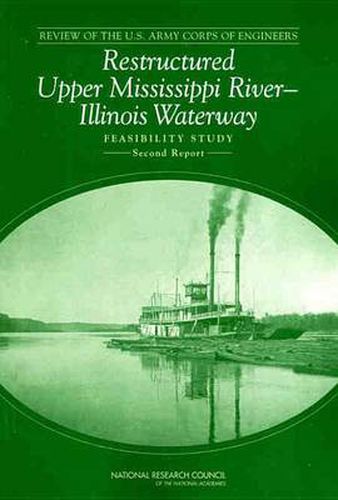Readings Newsletter
Become a Readings Member to make your shopping experience even easier.
Sign in or sign up for free!
You’re not far away from qualifying for FREE standard shipping within Australia
You’ve qualified for FREE standard shipping within Australia
The cart is loading…






For the past few years, the Corps has been working on what is known as the Restructured Upper Mississippi River-Illinois Waterway Feasibility Study, the heart of which is a multibillion-dollar proposal to double the length of up to a dozen locks on the river. The Research Council first reviewed the feasibility study in 2001 during controversies over the accuracy of models being used by the Corps to justify lock expansion based on increased demand for barge transportation. More than 100 million tons of cargo-half of it grain destined for international markets, the other half goods such as construction materials, coal, and chemicals-are shipped along the navigation system each year. The locks, which along with dams allow barges to traverse uneven river depths, were originally designed for tows of barges up to 600 feet long, but the length of a typical tow has increased, forcing the Corps to look for ways to relieve congestion.
The book finds the U.S. Army Corps of Engineers has made good progress in broadening its proposed plan for navigation improvements on the Upper Mississippi River-Illinois Waterway system to give greater consideration to ecological restoration. However, the plan still does not provide sufficient economic justification for expanding locks on the rivers because of flaws in the models the Corps used to predict demand for barge transportation. Little attention is paid to inexpensive, nonstructural navigation improvements that could help better manage existing levels of barge traffic. The revised plan has been usefully expanded to include many creative and potentially useful ecosystem restoration measures. These measures, however, should be more firmly grounded in river science principles and more broadly consider ways the river’s ecology might affect or be affected by navigation, recreation and other uses.
$9.00 standard shipping within Australia
FREE standard shipping within Australia for orders over $100.00
Express & International shipping calculated at checkout
For the past few years, the Corps has been working on what is known as the Restructured Upper Mississippi River-Illinois Waterway Feasibility Study, the heart of which is a multibillion-dollar proposal to double the length of up to a dozen locks on the river. The Research Council first reviewed the feasibility study in 2001 during controversies over the accuracy of models being used by the Corps to justify lock expansion based on increased demand for barge transportation. More than 100 million tons of cargo-half of it grain destined for international markets, the other half goods such as construction materials, coal, and chemicals-are shipped along the navigation system each year. The locks, which along with dams allow barges to traverse uneven river depths, were originally designed for tows of barges up to 600 feet long, but the length of a typical tow has increased, forcing the Corps to look for ways to relieve congestion.
The book finds the U.S. Army Corps of Engineers has made good progress in broadening its proposed plan for navigation improvements on the Upper Mississippi River-Illinois Waterway system to give greater consideration to ecological restoration. However, the plan still does not provide sufficient economic justification for expanding locks on the rivers because of flaws in the models the Corps used to predict demand for barge transportation. Little attention is paid to inexpensive, nonstructural navigation improvements that could help better manage existing levels of barge traffic. The revised plan has been usefully expanded to include many creative and potentially useful ecosystem restoration measures. These measures, however, should be more firmly grounded in river science principles and more broadly consider ways the river’s ecology might affect or be affected by navigation, recreation and other uses.